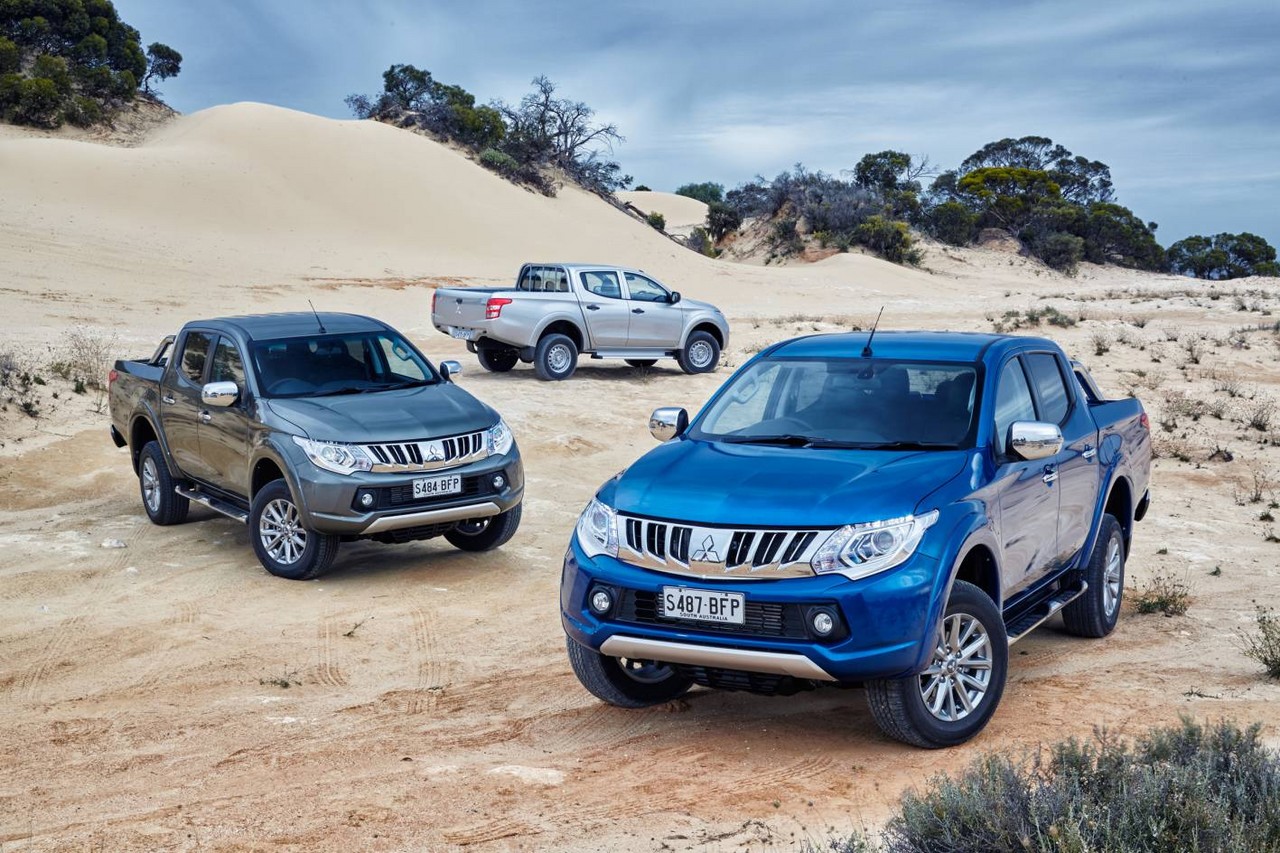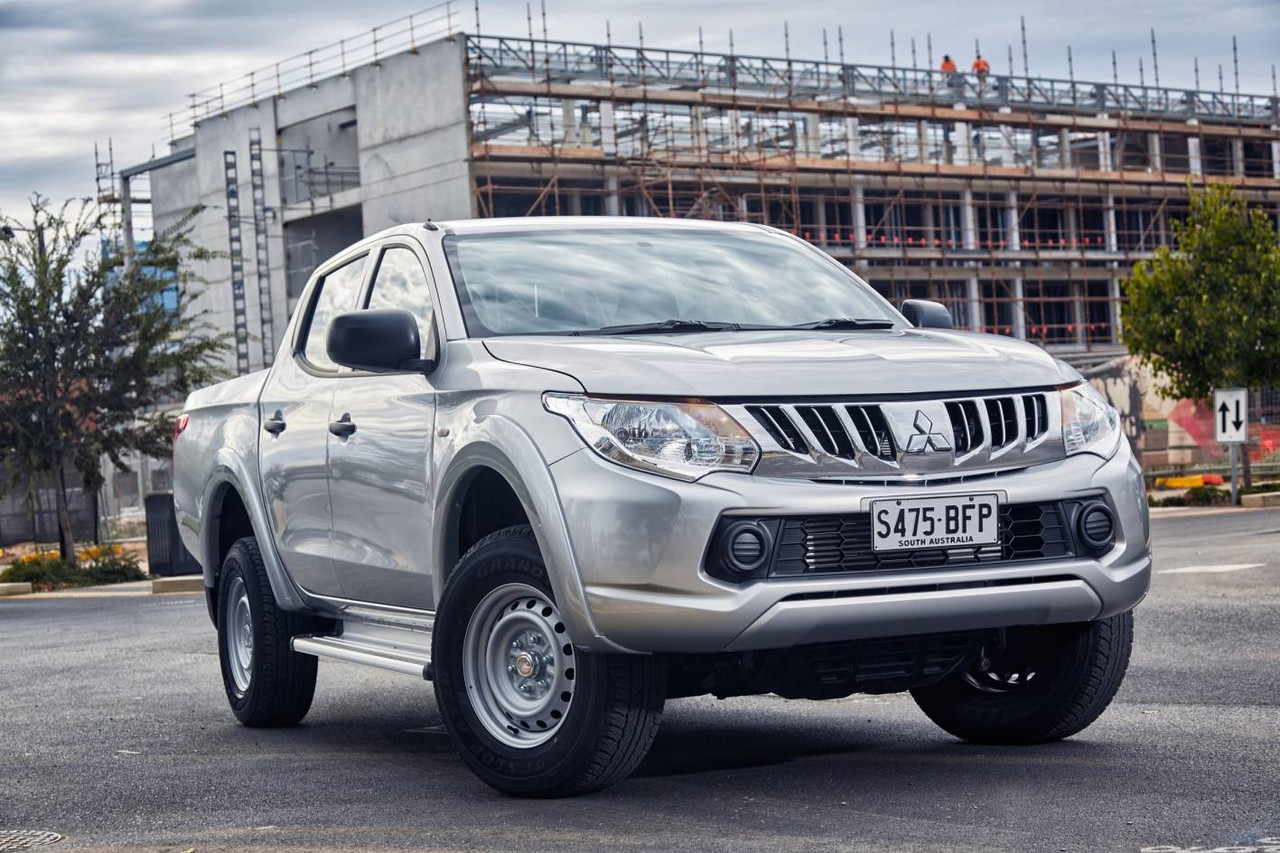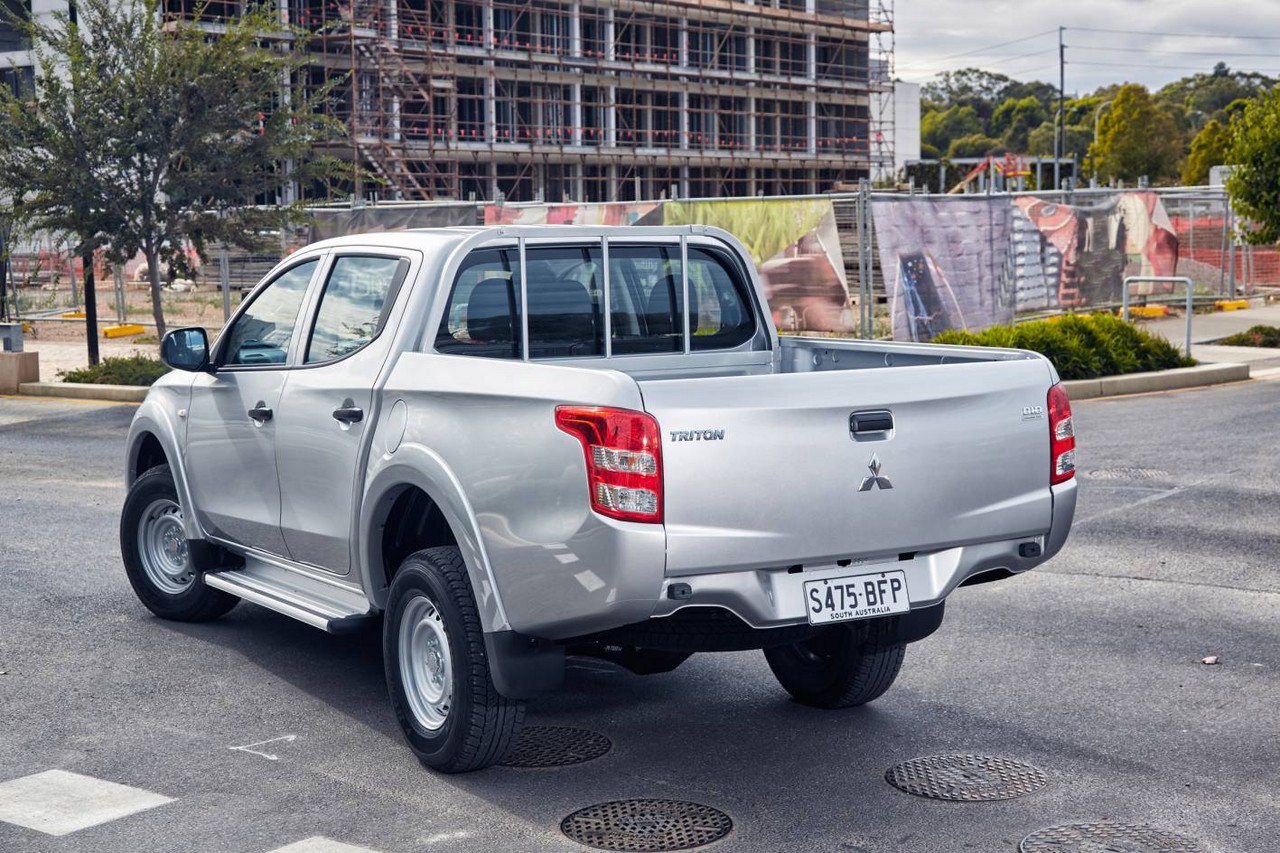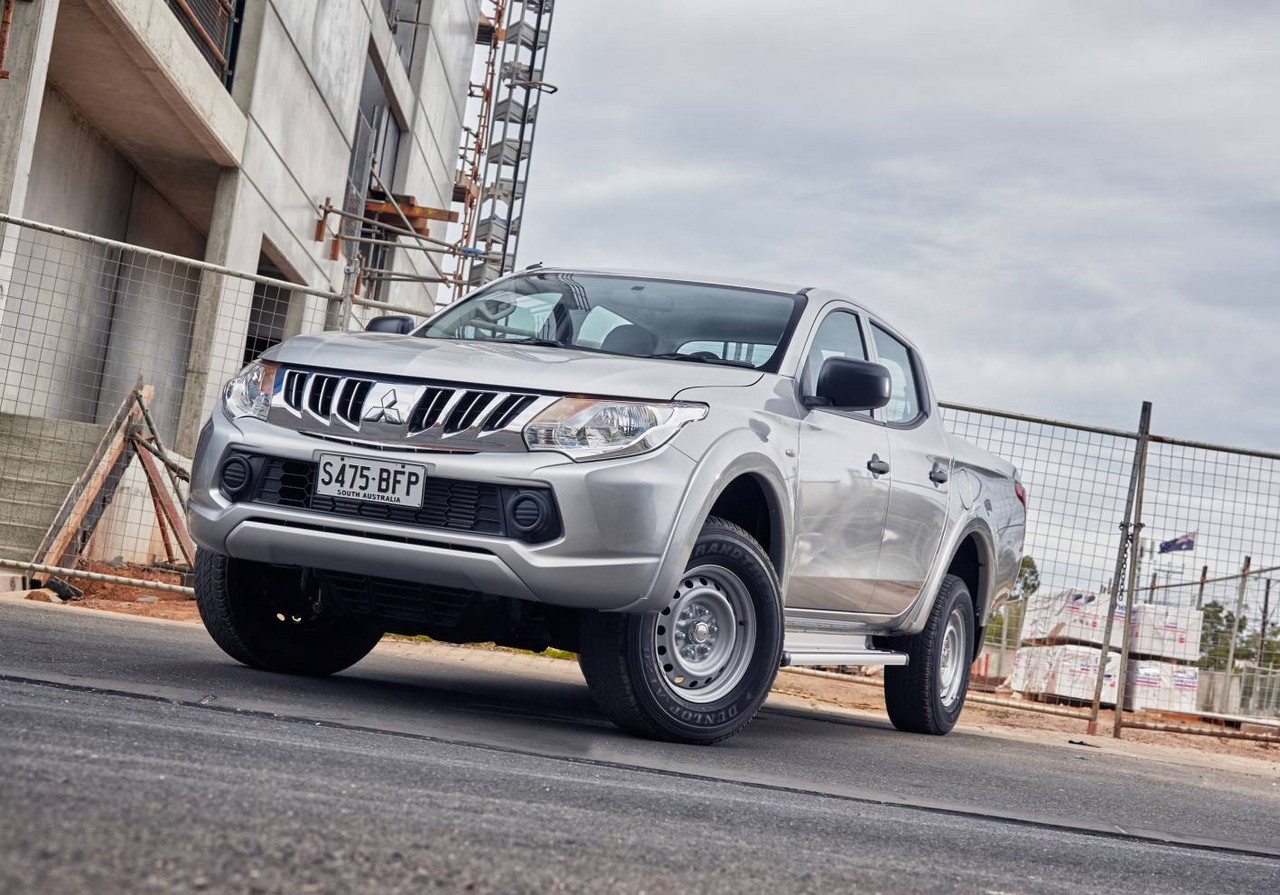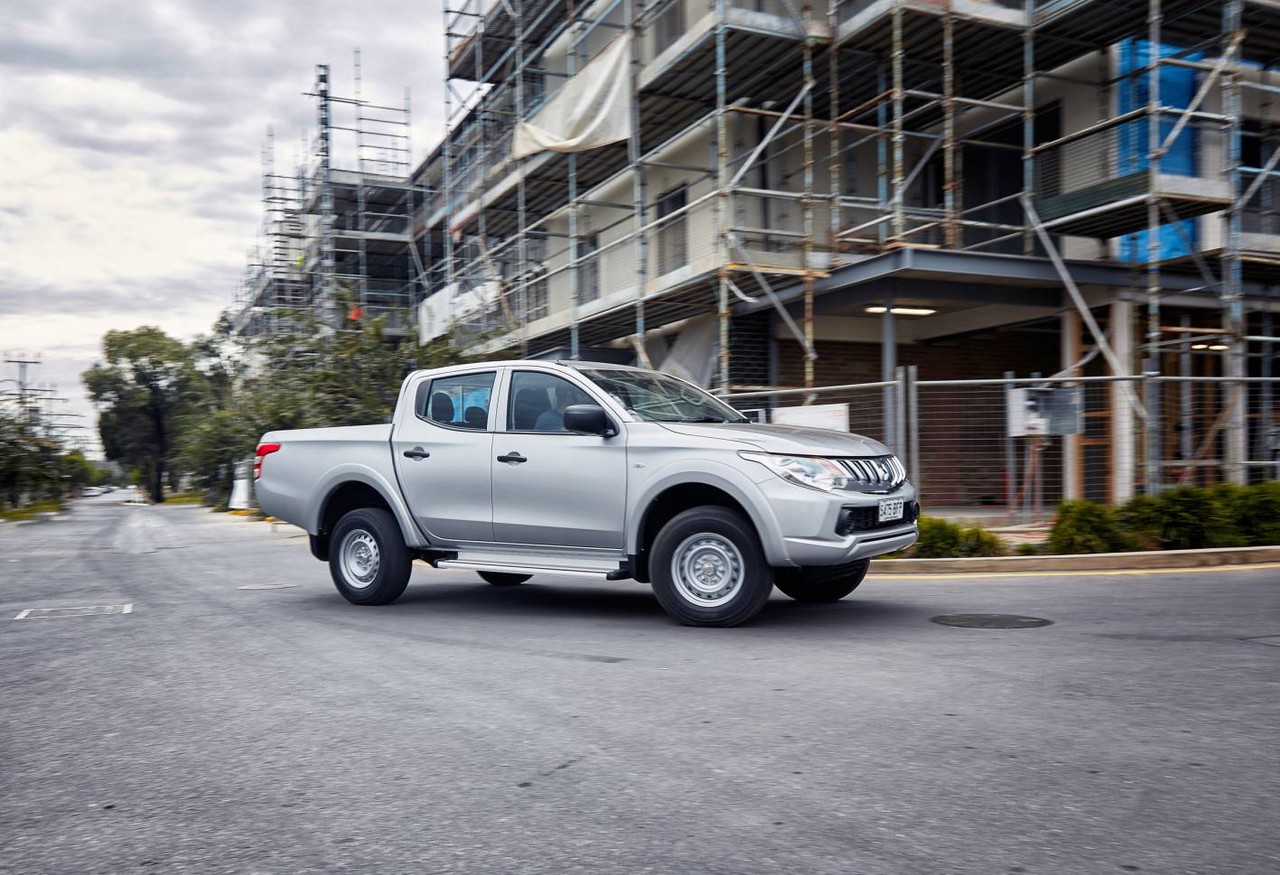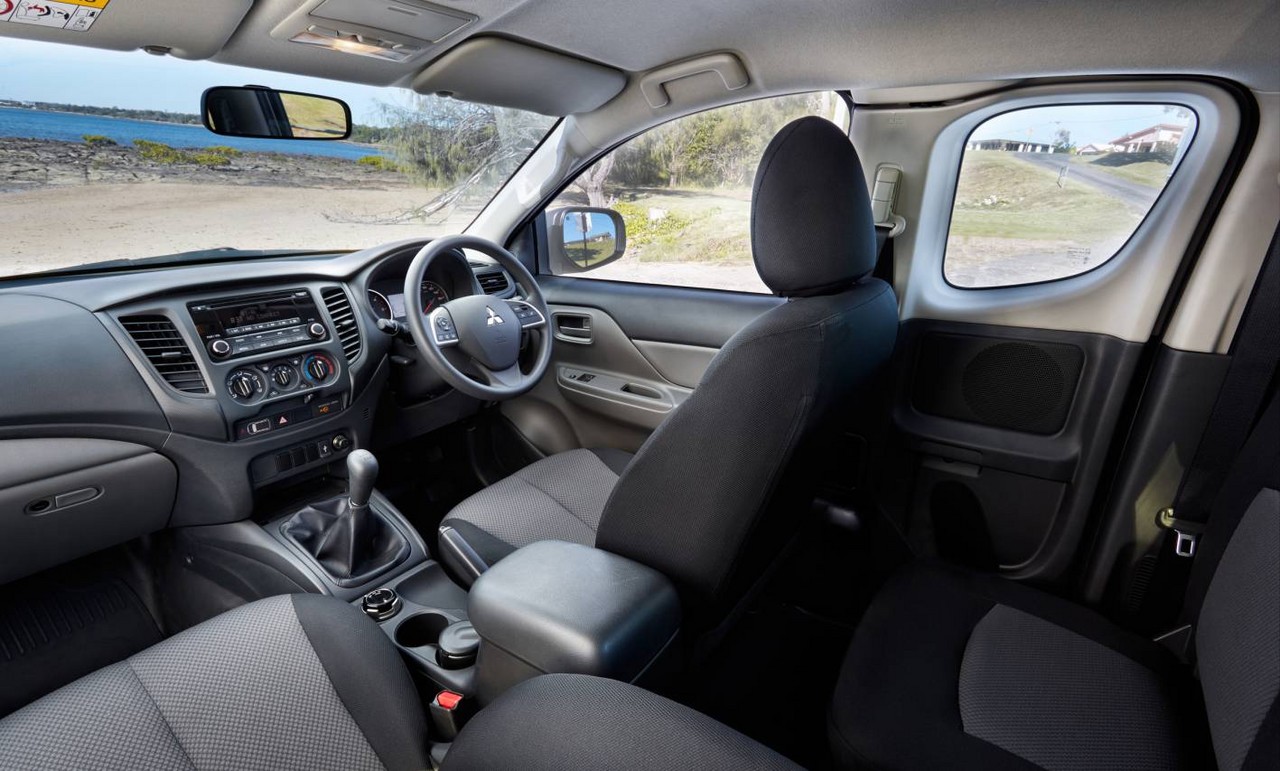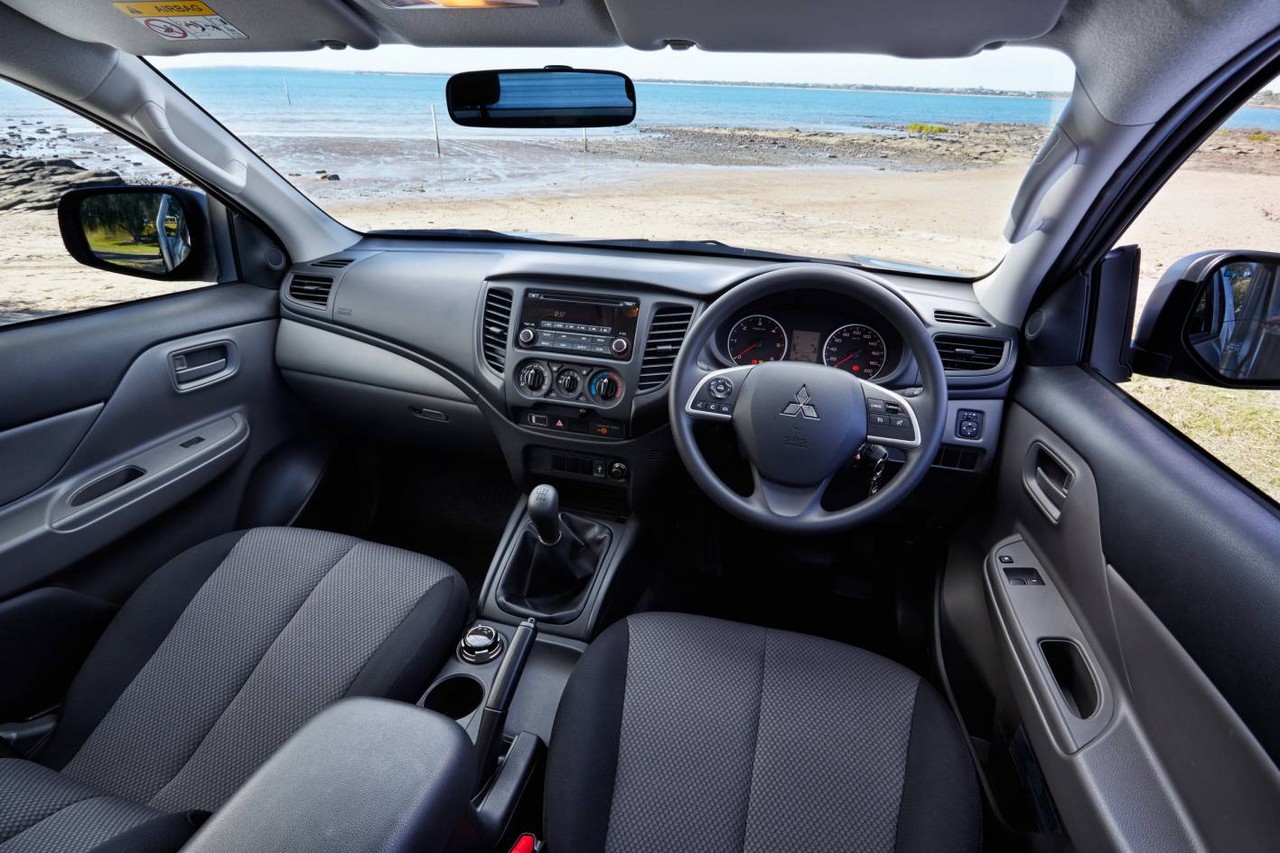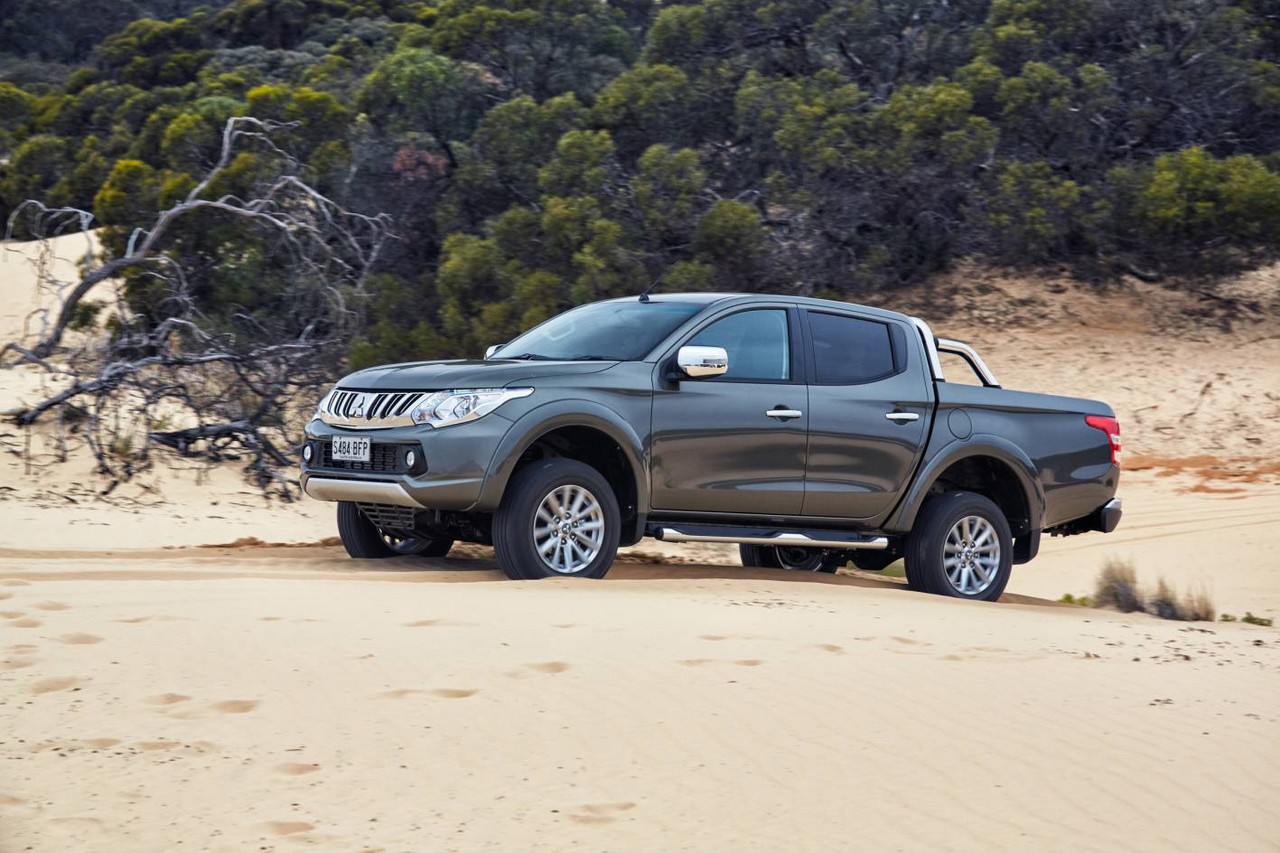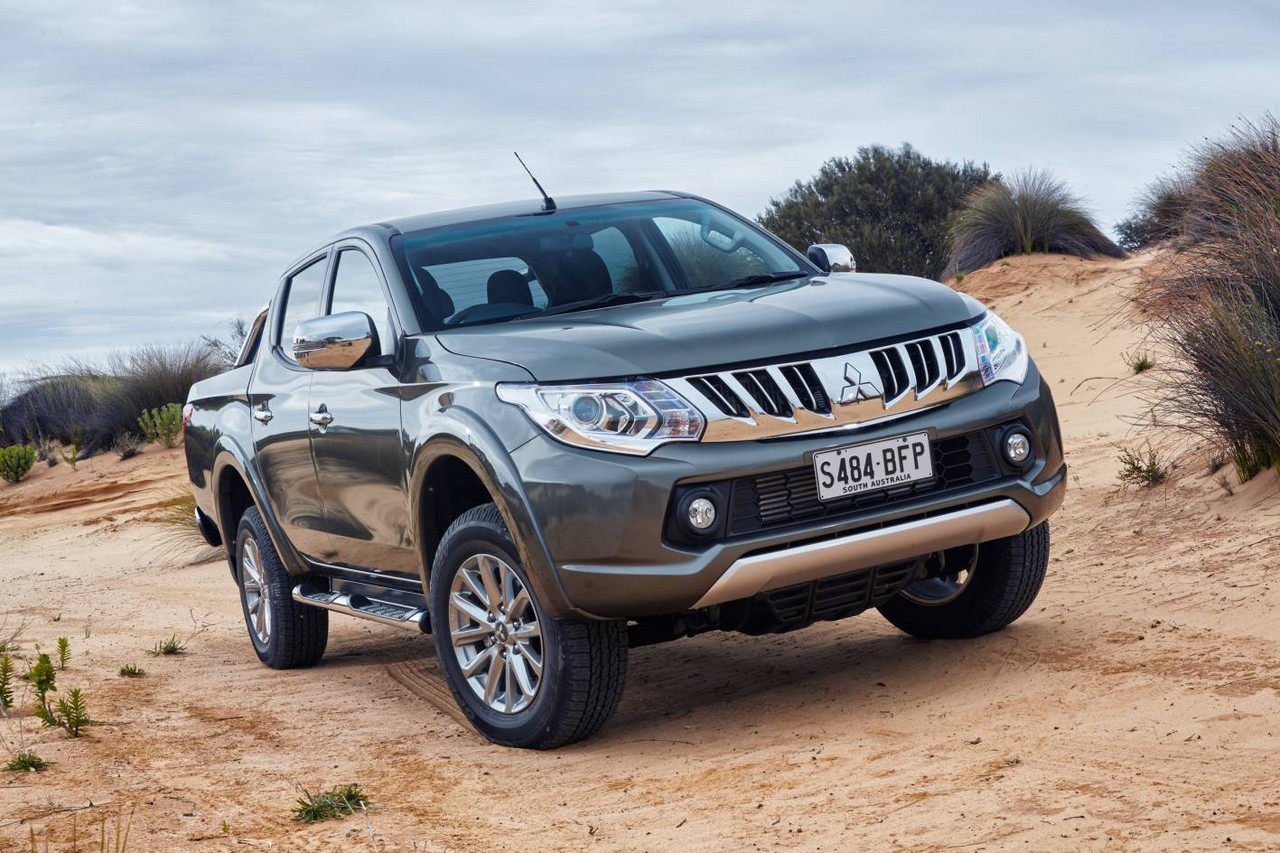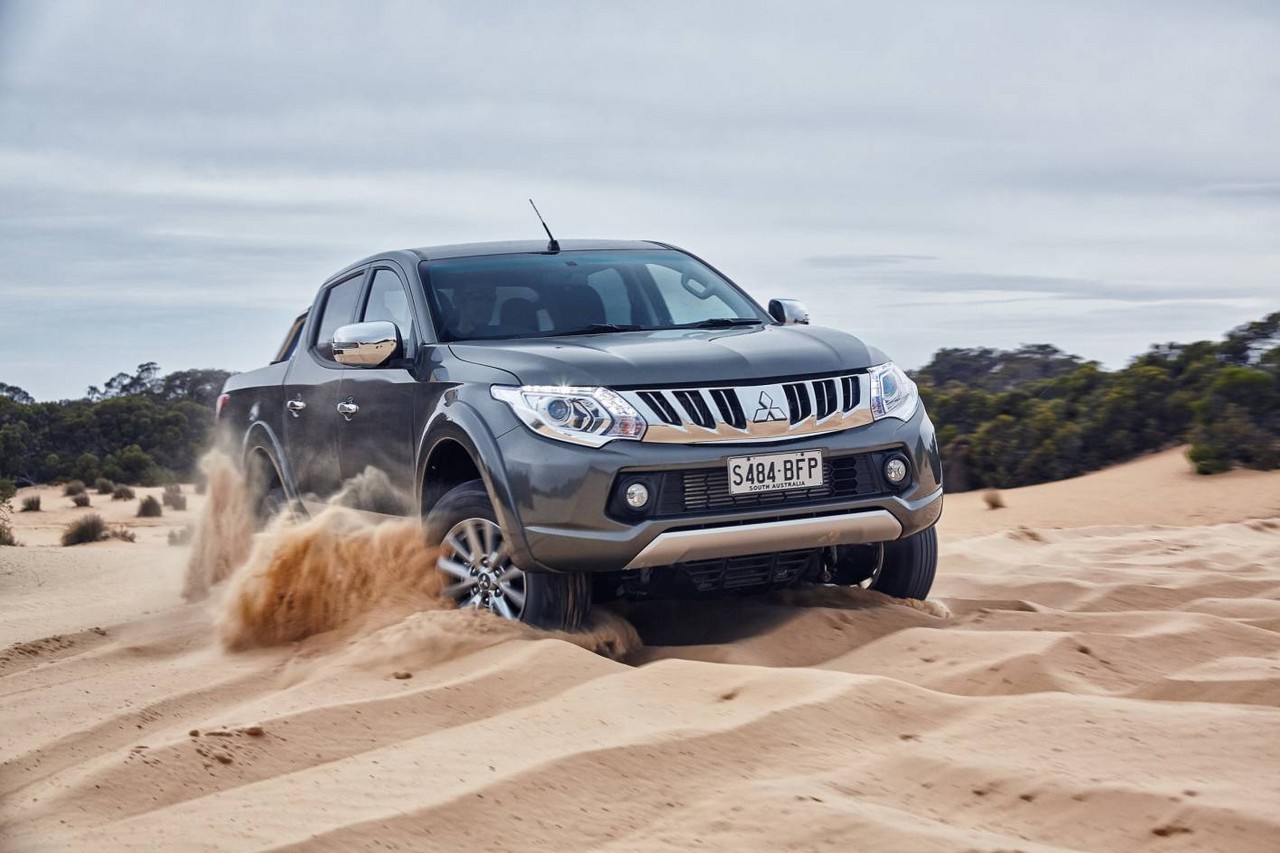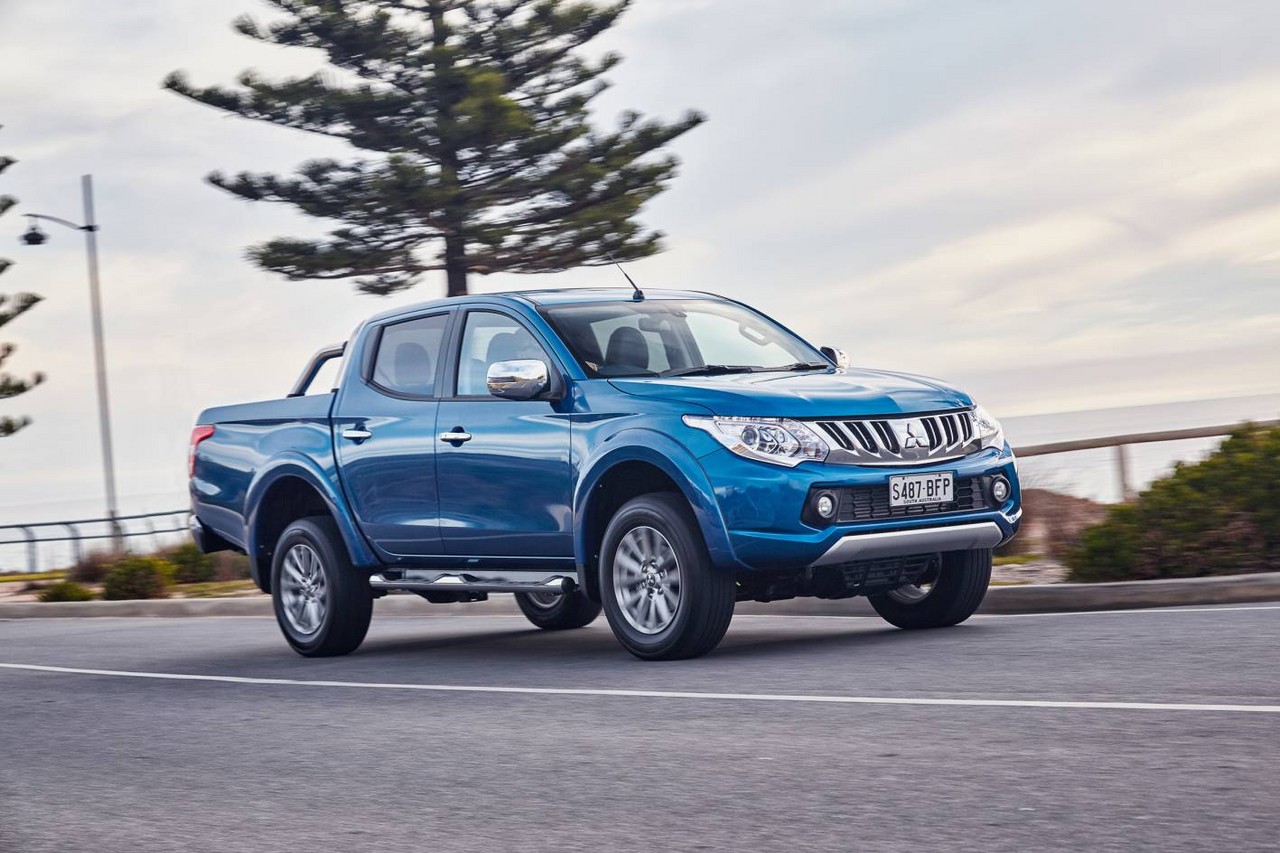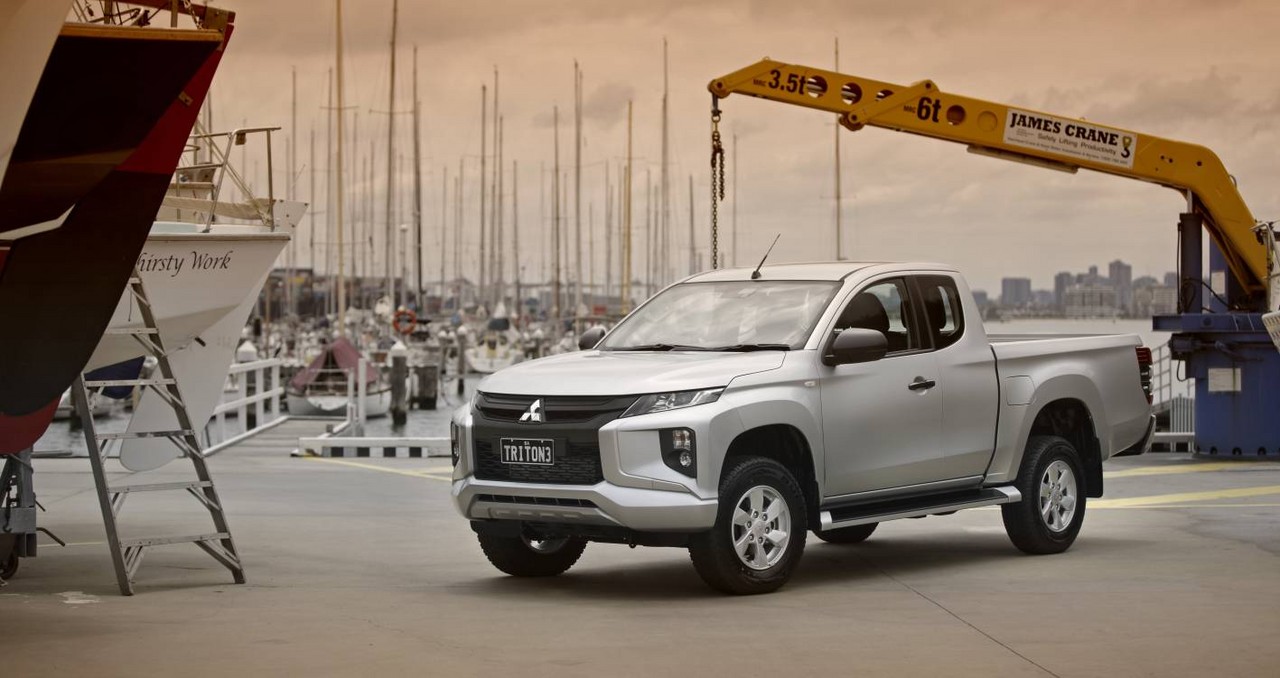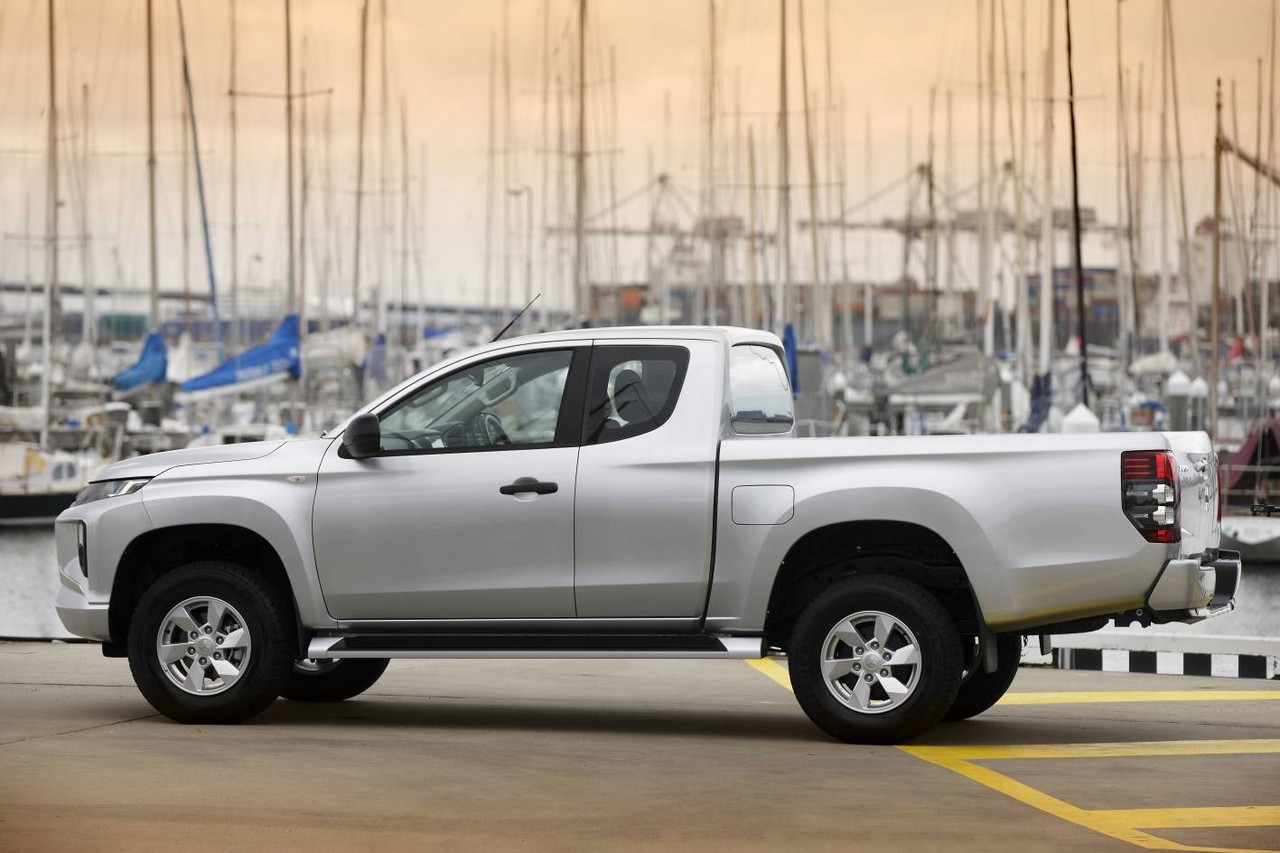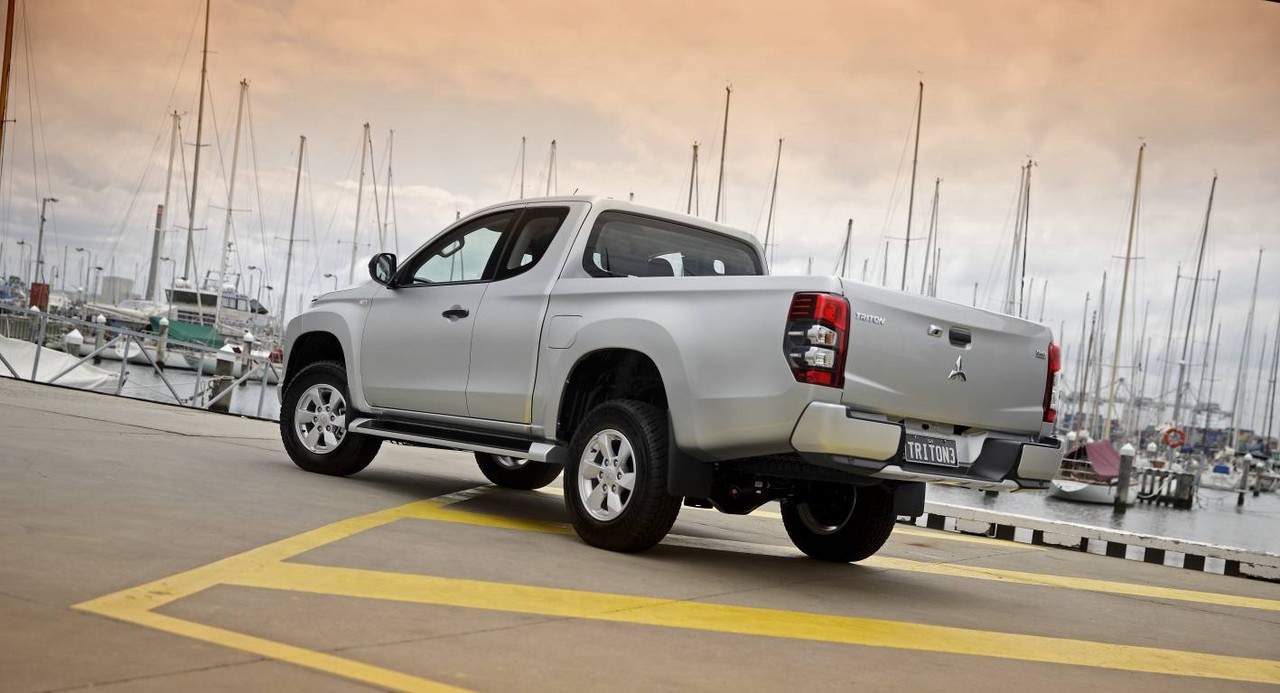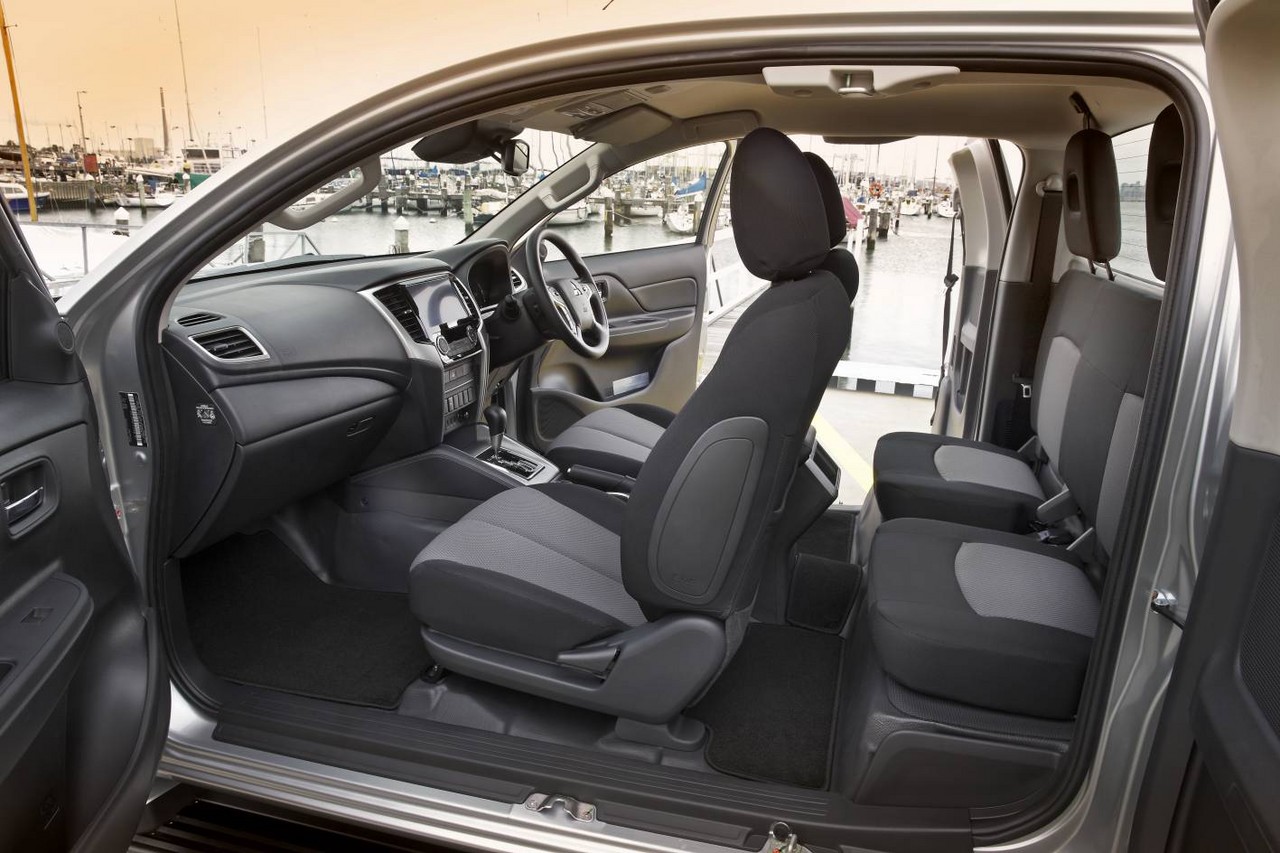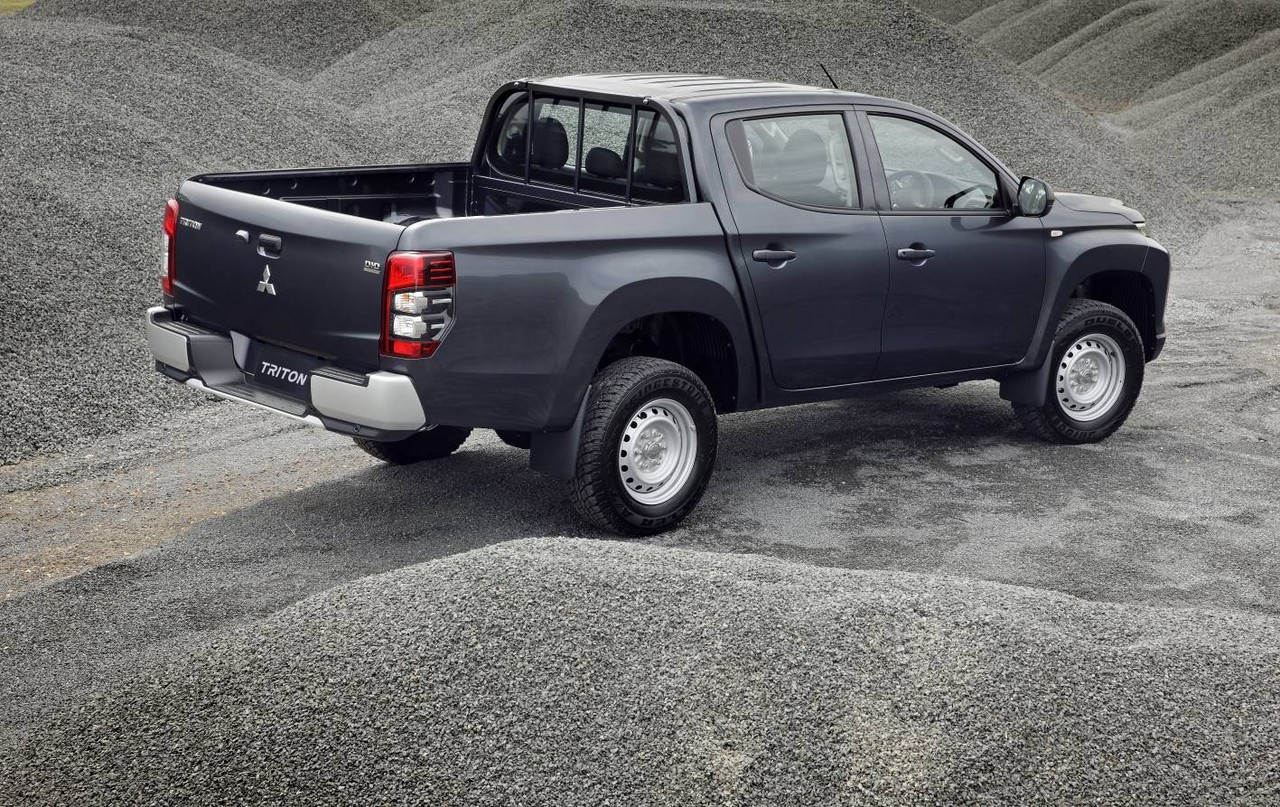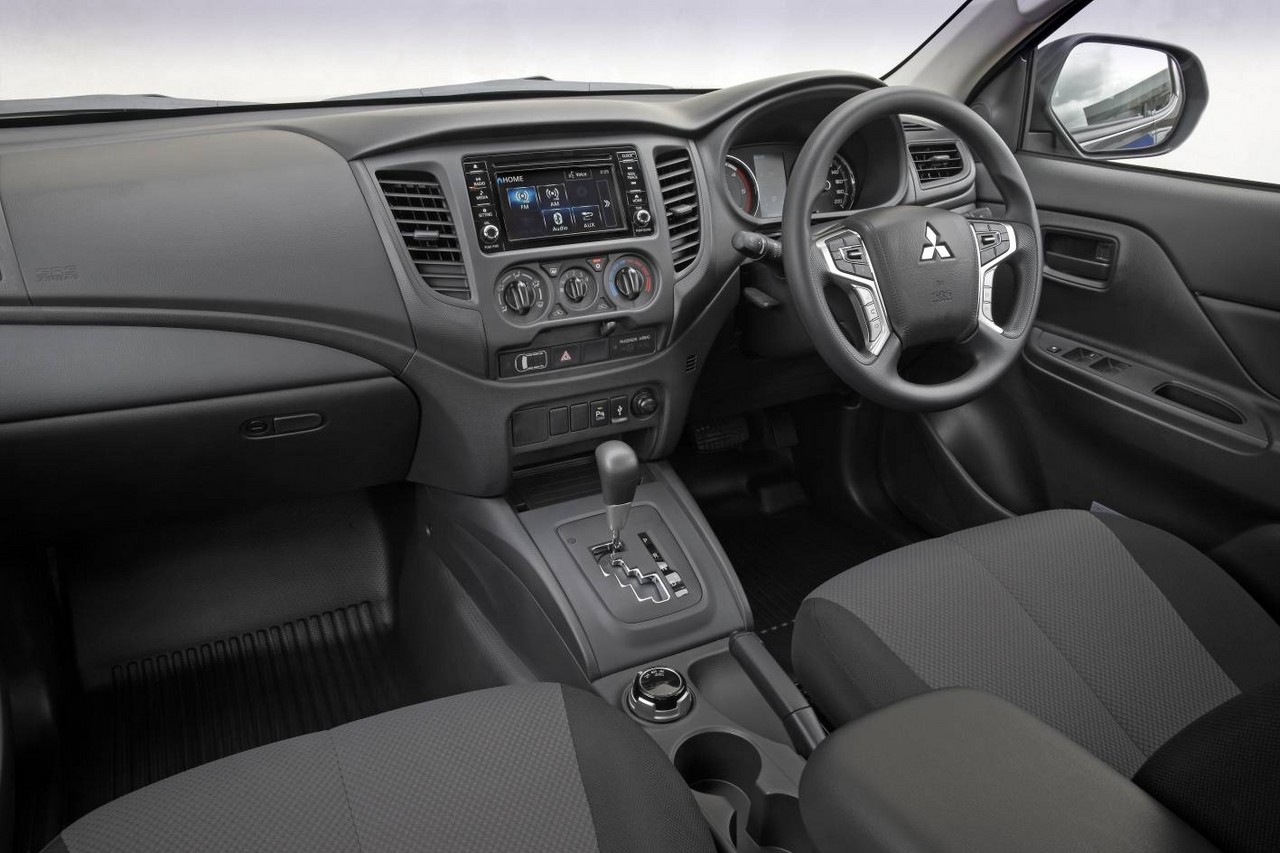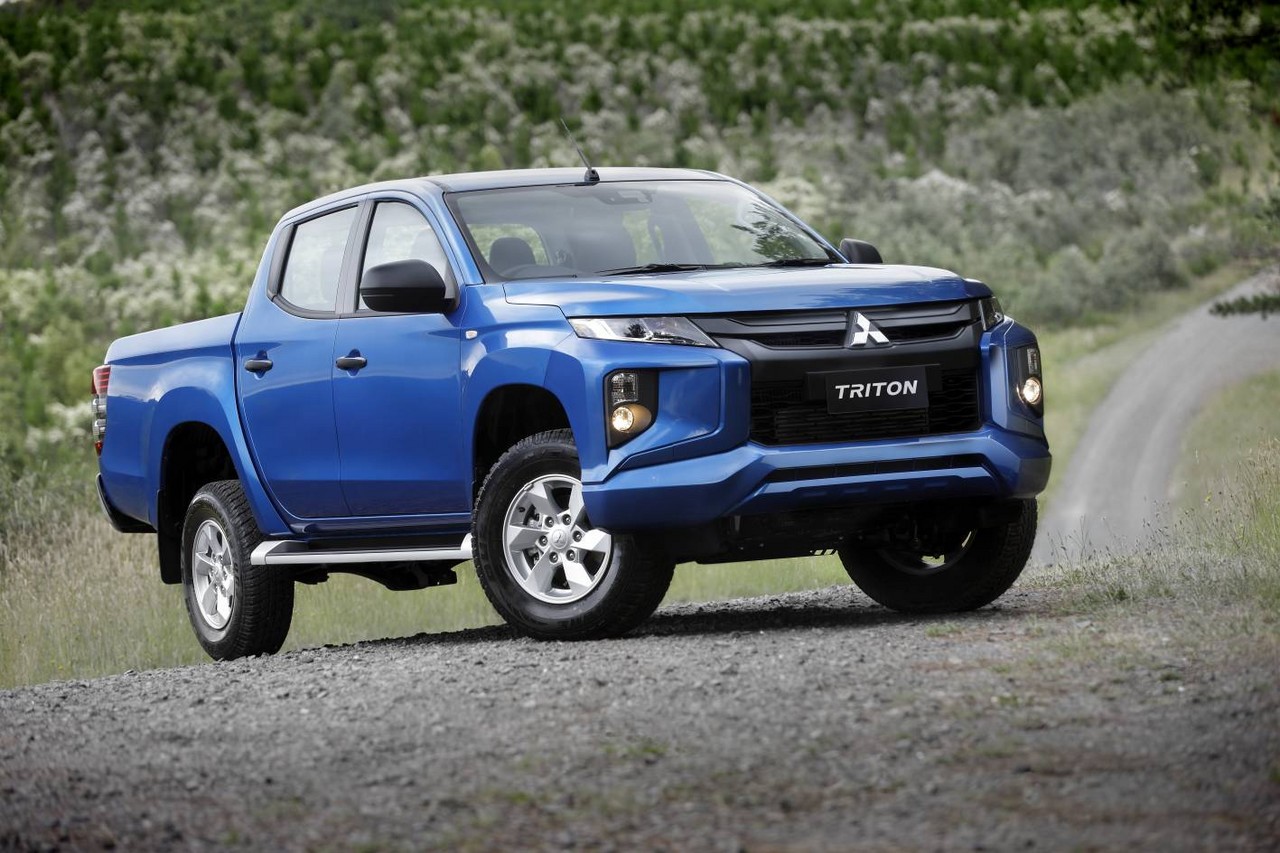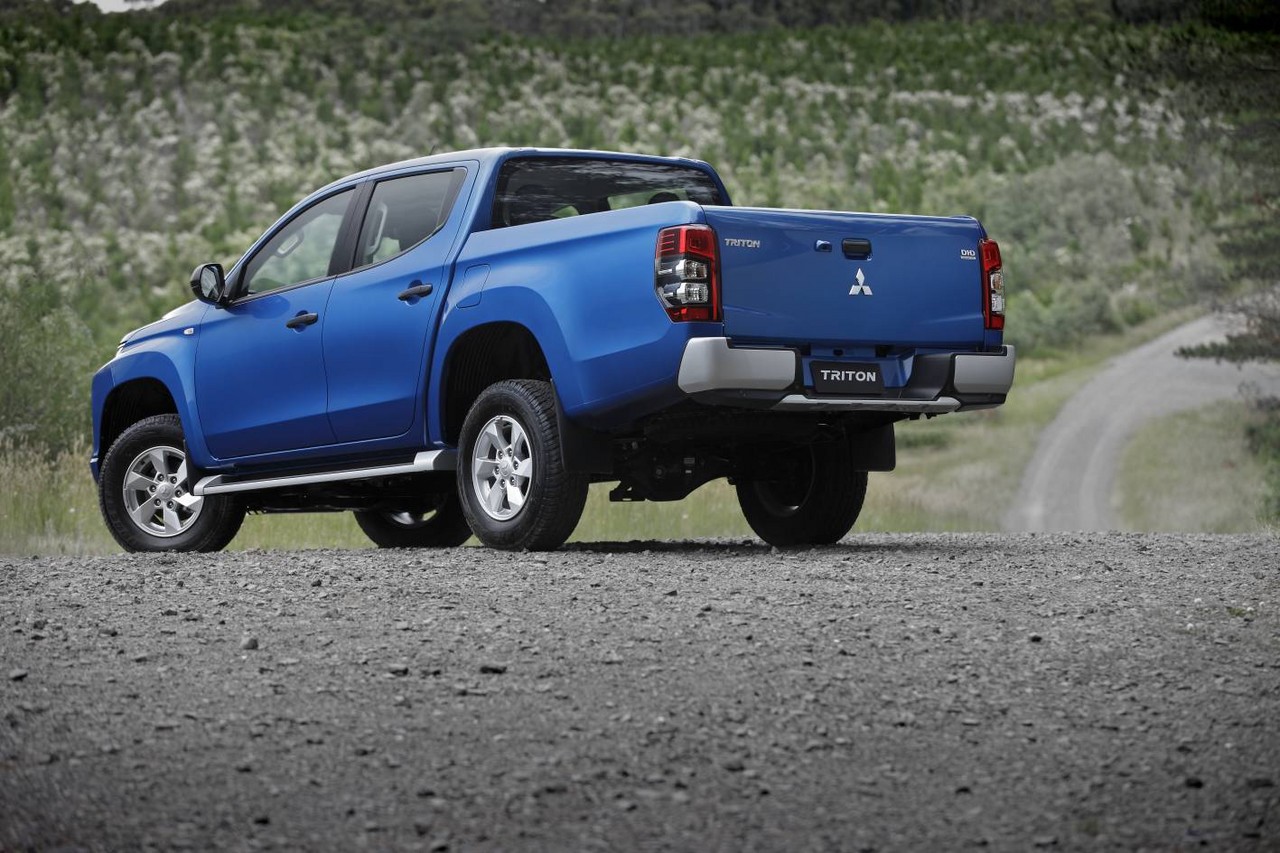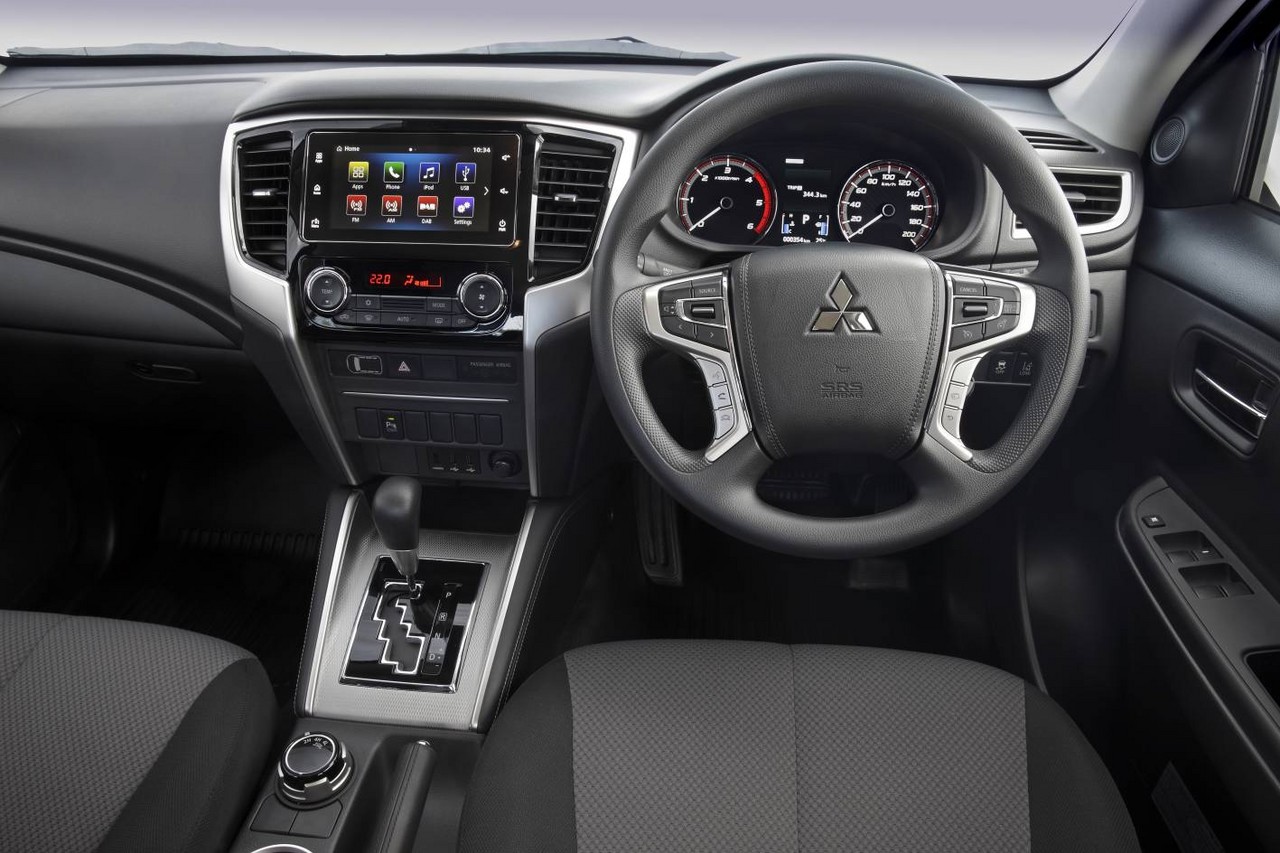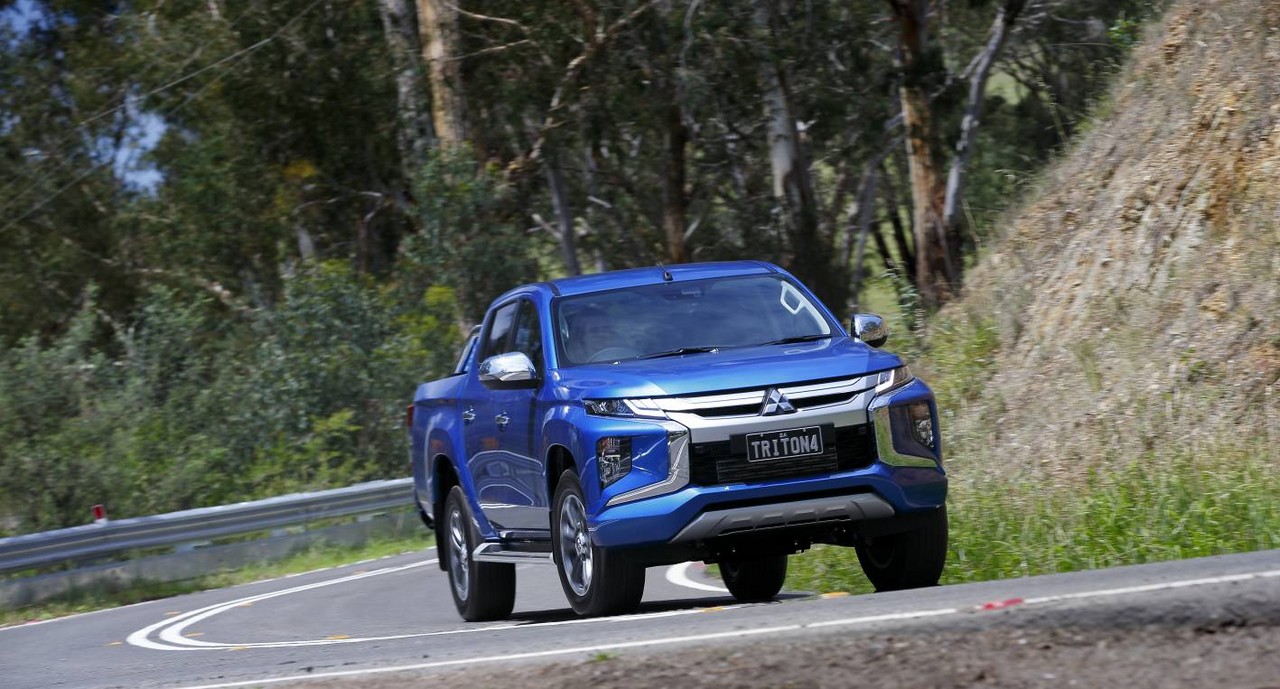
- Responsive and economical 2.4-litre turbo-diesel engine
- Quiet, well-insulated cabin
- Small turning circle
- Good ergonomics
- Firm, unsettled ride when unladen
- Reflections off chrome interior trim distract from door mirrors
- Limited interior storage
- For dual cabs, limited rear seat space
Review: Mitsubishi MQ.I Triton Utility (2015-18)
Overview
Released in Australia in April 2015, the fifth generation Mitsubishi MQ Triton utility was initially available in dual cab body. Manufactured at Mitsubishi’s Laem Chabang plant in Thailand, the Triton dual cab was available in rear- or four-wheel drive models and powered by Mitsubishi’s 2.4-litre 4N15 turbo-diesel engine; transmission options consisted of five-speed automatic or six-speed manual models.
As per the table below, the Triton utility range consisted of GLX, GLS and Exceed variants.
4N15 engine and transmissions
The newly developed 2.4-litre 4N15 turbo-diesel engine has a die-cast aluminium cylinder block and head, common-rail injection with piezo injectors, a variable geometry turbocharger, double overhead camshafts (with a maintenance-free timing chain), four valves per cylinder, a compression ratio of 15.5:1 and diesel particulate filter (DPF). The 4N15 engine also has Mitsubishi’s ‘MIVEC’ system which provides two-step control of intake valve timing and lift.
Of the transmissions,
- the six-speed manual transmission had triple-cone synchromesh on the first, second and third gears, as well as a dual mass flywheel to reduce engine vibration; and,
- the five-speed Aisin automatic transmission had a gate-type shift pattern and ‘Sport Mode’ for sequential shifting.
| Body | Variant | Engine | Drive | Trans. | Peak power | Peak torque |
|---|---|---|---|---|---|---|
| Double Cab |
GLX | 2.4-litre turbo-diesel I4 | RWD | 5sp auto | 133 kW at 3500 rpm | 430 Nm at 2500 rpm |
| 4×4 | 6sp man., 5sp auto |
|||||
| GLS | 2.4-litre turbo-diesel I4 | 4×4 | 6sp man., 5sp auto |
133 kW at 3500 rpm | 430 Nm at 2500 rpm | |
| Exceed | 2.4-litre turbo-diesel I4 | 4×4 | 5sp auto | 133 kW at 3500 rpm | 430 Nm at 2500 rpm |
4WD system
The Triton GLX was fitted with Mitsubishi’s ‘Easy Select’ 4WD system which, via a four-wheel drive selector dial, enabled the driver to select from the following drive modes –
- 2H: rear-wheel drive with high range gears;
- 4H: four-wheel drive with high range gears; and,
- 4L: four-wheel drive with low range gears. For the 2015 Triton, the sub-transmission used low gearing for improved all-terrain performance in 4L.
Furthermore, the driver could switch between 2H and 4H while driving at speeds of up to 100 km/h.
The Triton GLS and Exceed were fitted with Mitsubishi’s new ‘Super Select four-wheel drive II’ system. In addition to 2H, 4H and 4L modes, the Super Select II system included a locked 4×4 mode. The Super Select II system also had a 40:60 front:rear torque distribution in its full-time 4×4 mode.
The Triton Exceed was equipped with an electronically-controlled rear differential lock.
Body and dimensions
According to Mitsubishi, the MQ Triton had a more rigid chassis frame and cab, with torsional rigidity in the chassis frame increasing by 7 per cent compared to its MN Triton utility predecessor.
The Triton double cab was 5200 mm long, 1815 mm wide, 1780 mm tall and had a 3000 mm long wheelbase; the cargo bed was 1520 mm wide, 1470 mm wide and had a depth of 475 mm. Furthermore, ground clearance was 205 mm, providing approach and departure angles of 30 degrees and 28 degrees, respectively.
For the 4×4 Double Cab models with automatic or manual transmissions, maximum braked towing capacity was 3.1 tonne.
Suspension
The Mitsubishi MQ Triton had double wishbone front suspension and leaf spring rear suspension. Relative to its predecessor, however, changes included:
- an upgraded front stabiliser bar;
- revised spring rates;
- optimised shock absorber characteristics;
- a bush-type stab bar lower link for the front suspension; and,
- for the rear leaf springs, mounting position and length were extended by 120 mm.
Safety equipment
Standard safety equipment for the Mitsubishi MQ Triton included dual front airbags, a driver’s knee airbag, front seat-mounted side airbags, full-length curtain airbags, ABS, electronic brake force distribution, brake assist, electronic stability control (including trailer stability assist), traction control and front seatbelts with pretensioners and load limiters.
ANCAP crash testing
In ANCAP crash testing , the 2015 Triton dual cab received a five star adult occupant protection rating with a score of 36.22 out of 37. In the frontal offset crash test, occupant protection was generally rated as good, though protection of the driver’s chest and lower legs was rated as acceptable (i.e. a slight risk of serious injury). For the side impact and pole tests, maximum points were awarded.
Features: Triton GLX
Standard features for the Mitsubishi Triton GLX utility included 16 x 7.0J steel wheels with 245/70 R16 111S RF tyres, a four speaker sound system with a radio and CD player, USB port, Bluetooth mobile phone connectivity and audio streaming with voice control, air conditioning, front bucket seats, cloth seat trim, cruise control, halogen headlights, remote central locking, power mirrors, front power windows, tilt and telescopic steering wheel adjustment, a height adjustable driver’s seat, trip computer, an alarm and immobiliser.
Features: Triton GLS
Compared to the Triton GLX, the Triton GLS was further equipped with 17 x 7.5J alloy wheels with 245/65 R17 111S tyres, six speaker sound system with digital radio tuner (DAB), CD player and a 6.1-inch colour touch screen, dual-zone climate control air conditioning, sports cloth seat trim, high intensity discharge (HID) headlights, LED daytime running lights, front fog lights, a rear view camera, three-spoke leather steering wheel, leather gear knob, power folding door mirrors with integrated indicators, piano black and silver dashboard trim, fabric door inserts, ambient temperature indicator.
Visual cues for the Triton GLS included a painted front bumper under garnish, sports bar, side steps and rear step bumper.
Features: Triton Exceed
The range-topping Triton Exceed was distinguished by its Mitsubishi Multi Communication System (MMCS) with a seven inch touch screen, 3D navigation mapping and SD card input, a power adjustable driver’s seat, leather seats, automatic headlights, rain-sensing wipers, proximity key for keyless entry, steering wheel gearshift paddles, and push-button start.
December 2016 update
In December 2016, the following changes were introduced for the Mitsubishi Triton range:
- The Triton GLX was equipped with a six speaker sound system with digital radio tuner (DAB) and 6.1-inch colour touch screen (previously fitted to the Triton GLS). An automatic, speed-sensing door lock was also introduced as standard across the range;
- For the Triton GLX dual cab utility, standard features were extended to include a reversing camera;
- Mitsubishi Triton GLX 4×4 and GLX+ 4×4 variants were also fitted with all-terrain tyres for greater off-road ability;
- The Triton GLS and Exceed gained Mitsubishi’s ‘Smartphone Display Audio’ (SDA) system which had a seven-inch colour touchscreen. For the Triton Exceed, the SDA system replaced the Mitsubishi Multi Communication System (MMCS). The post-December 2016 Triton GLS and Exceed could be identified by their dark chrome front fascias and headlight garnishes, and were fitted with platform-style side steps; and,
- For the Triton Exceed, standard features were extended to include heated front seats and an electrochromatic rear view mirror.
2017 Mitsubishi Triton GLS Sports Edition
Based on the Mitsubishi Triton GLS Double Cab 4×4, the Triton GLS Sports Edition was released in February 2017. Compared to the Triton GLS, the GLS Sports Edition could be identified by its ‘black out’ front fascia and black finishes for the headlamp garnishes, 17-inch alloy wheels, fender flares, side step assemblies, sports bar and rear step bumper. As standard, the GLS Sports Edition was also fitted with several Mitsubishi Genuine Accessories, such as a nudge bar with a black powder coat finish, tub liner, tinted bonnet protector, soft tonneau cover, tow bar and tow ball, and carpet mats.
Like the Triton Exceed, the Triton GLS Sports Edition was also fitted with a rear differential lock.
2018 Mitsubishi Triton Blackline
The limited-run Mitsubishi Triton Blackline was released in March 2018. The Triton Blackline was based on the GLS Double Cab 4×4, but further equipped with a proximity key, push button start, tub liner and carpet mats. Visually, the Mitsubishi Triton Blackline could be identified by its black finish 17-inch alloy wheels, black mesh grille, black door mirrors, black door handles, ‘Triton Blackline’ door decal and black finishes for the fender flares, side steps, rear step bumper and sports bar. Furthermore, the Mitsubishi Triton Blackline was available in Black, Starlight and Titanium paint finishes.
Paint colours
The Mitsubishi MQ Triton was available in the following paint finishes:
- White;
- Black pearl;
- Red;
- Sterling Silver metallic;
- Titanium Grey metallic;
- Impulse Blue metallic; and,
- Earth Green metallic.
Specifications
Review: Mitsubishi MQ.II Triton Utility (2018-on)
Overview
Production of the Mitsubishi MQ.II Triton utility commenced in November 2018 and it was released in Australia in January 2019. For the MQ.II Triton range, six-speed automatic transmissions were introduced, the ‘Exceed’ variant was effectively replaced by the GLS Premium (see table below) and active safety technologies were fitted as standard for GLX ADAS, GLX+, GLS and GLS Premium variants.
Changes for MQ.II Triton
Visually, the MQ.II Triton could be identified by its new front mask which was based on Mitsubishi’s ‘Dynamic Shield Concept’. As part of this, the bonnet line was raised, the fog lamps repositioned and larger chrome elements were utilised. Inside, the MQ.II Triton introduced a monotone colour scheme, soft-touch materials and stitching for contact areas and, for door trims, thicker-gauge laminate and stitching.
Other changes for the MQ.II Triton included:
- Reinforcements to increase rigidity in the engine compartment surrounds and in the chassis frame, cab and cargo bed joins;
- Larger-capacity rear dampers to improve ride comfort; and,
- Changes to the rear leaf springs to improve comfort on paved surfaces and directional stability on unmade roads.
| Body | Engine | Drive | Variant | Trans. | Peak power | Peak torque |
|---|---|---|---|---|---|---|
| Club Cab | 2442 cc 4N15 turbo diesel I4 | 4×4 | GLX+ | 6sp man., 6sp auto |
133 kW at 3500 rpm | 430 Nm at 2500 rpm |
| Dual Cab | 2442 cc 4N15 turbo diesel I4 | 4×2, 4×4 |
GLX ADAS | 6sp auto | 133 kW at 3500 rpm | 430 Nm at 2500 rpm |
| 4×4 | GLX, GLX ADAS, GLX+, GLS |
6sp man., 6sp auto |
133 kW at 3500 rpm | 430 Nm at 2500 rpm | ||
| GLS Premium | 6sp auto | 133 kW at 3500 rpm | 430 Nm at 2500 rpm |
Super-Select 4WD-II system
The Mitsubishi MQ.II Triton GLS and GLS Premium were fitted with Mitsubishi’s ‘Super-Select 4WD-II’ four-wheel drive system. With ‘Super-Select 4WD-II’, the driver could:
- Select from the following drive modes –
- 2H (rear wheel drive, high-range): for dry asphalt surfaces where four-wheel drive was not needed;
- 4H (four-wheel drive, high-range): for surfaced and unsurfaced roads;
- 4HLc (four-wheel drive, high-range, locked centre differential): for snow covered roads or sand; and,
- 4LLc (four-wheel drive, low range, locked centre differential): for rock or mud surfaces at low speed.
- Select from Gravel, Mud/Snow, Sand and Rock modes which sought to improve traction through the integrated control of engine power, automatic transmission and wheel slip parameters; and,
- Engage ‘Hill Descent Control’ (HDC) which could maintain a constant vehicle speed less than 20 km/h when descending a gradient.
The Triton GLS Premium was also fitted with an electronic differential lock.
Safety equipment
For the Mitsubishi MQ.II Triton, safety equipment for the Triton GLX ADAS, GLX+, GLS and GLS Premium was extended to include:
- Front Collision Mitigation (FCM) with autonomous braking: used camera and laser radar systems to detect cars and pedestrians. When there was a risk of a collision, the driver would initially be warned by an audible alert. If the driver failed to respond, ‘firm’ braking would be applied automatically to reduce vehicle speed. If a collision was imminent, emergency braking would be applied to increase the rate of deceleration; and,
- Lane Departure Warning (LDW): used the forward-facing camera to detect lane markings. If the Triton drifted out of its lane without the indicators having been applied, then an audible alert would sound and a warning would be displayed in the multi-function display.
The Mitsubishi Triton GLS (with automatic transmission) and GLS Premium were further equipped with:
- Blind Spot Warning with Lane Change Assist: used a microwave radar inside the rear bumper to detect vehicles in the driver’s blind spot. If detected, a light in the door mirror on that side of the vehicle would flash to alert the driver. If the driver indicated to move in the direction of the detected vehicle, the door mirror indicator would flash and a buzzer would sound;
- Rear Cross Traffic Alert (RCTA): used a microwave radar inside the rear bumper to detect vehicles behind or approaching the Mitsubishi Triton. If detected, the door mirror indicator repeater would flash, a buzzer would sound and a warning message would appear in the instrument cluster; and,
- Ultrasonic misacceleration Mitigation System (UMS): when moving from rest (forwards or reverse), UMS would restrict acceleration if an obstacle was detected in the direction of movement and an alert would sound.
Features: Mitsubishi Triton GLX
The Triton GLX and GLX ADAS were equipped with Mitsubishi’s ‘Display Audio’ system which had a 6.1-inch touchscreen, CD player, USB input, Bluetooth mobile phone connectivity with voice control and audio streaming; dual cab models had a four speaker audio system.
Beyond this, standard features for the Mitsubishi Triton GLX included cruise control, halogen headlights and daytime running lights, front fog lamps, remote central locking, power mirrors, power windows, tilt and telescopic steering wheel adjustment, two 12 volt power sockets, vinyl floor covering, a trip computer and an immobiliser.
Features: Mitsubishi Triton GLX ADAS
Compared to the Triton GLX, the Triton GLX ADAS added dusk-sensing headlights, rain-sensing wipers, rear view camera, rear parking sensors and an electrochromatic rear view mirror.
Features: Mitsubishi Triton GLX+
The Triton GLX+, GLS and GLS Premium were equipped with Mitsubisih’s ‘Smartphoen link Display Audio’ system which had a 7.0-inch touchscreen, digital radio tuner (DAB), two USB inputs, an HDMI input, Android Auto and Apple CarPlay, though omitted the CD player of the ‘Display Audio’ system. Additional features for the Triton GLX+ included 16-inch alloy wheels, climate control air conditioning and side steps.
Features: Mitsubishi Triton GLS
Relative to the Triton GLX+, the Triton GLS added 18-inch alloy wheels, six speaker audio system, dual-zone climate control air conditioning, ‘premium’ seat fabrics, LED headlights (low- and high-beam) with Automatic High Beam (AHB), LED daytime running lights, front parking sensors, power folding door mirrors with integrated indicators, second row USB power supply, carpet floor covering, rear privacy glass, chrome door handles and a sports bar.
Features: Mitsubishi Triton GLS Premium
The range-topping Triton GLS Premium was distinguished by its leather-faced seats, heated front seats, a power adjustable driver’s seat, proximity key, push-button start, tub liner, black nudge bar and Multi Around Monitor (MAM) which used four cameras located at the front, rear and in the door mirrors to monitor the area around the vehicle and generate a bird’s eye view of the vehicle and obstacles that was shown on the central display. When the driver selected reverse, the monitor would impose a grid overlay with guidelines on the rear-view image to provide assistance.
October 2019 update (‘MY20’)
The ‘2020 model year’ Mitsubishi MQ.II Triton was released in Australia in October 2019. As part of this update,
- Triton GLX+, GLS and GLS Premium variants could be specified with a rear differential lock (previously reserved for the GLS Premium);
- The Triton GLX+ 4×4 was equipped with Mitsubishi’s ‘Easy-Select 4WD’ for easy switching between 2WD and 4WD modes; it also included 2H, 4H and 4L transfer case settings;
- Double cab Triton GLX+ variants were fitted with a rear air circulator; and,
- Triton GLS variants were equipped with a proximity key for keyless entry and push-button start.
Specifications and brochure
Related links
